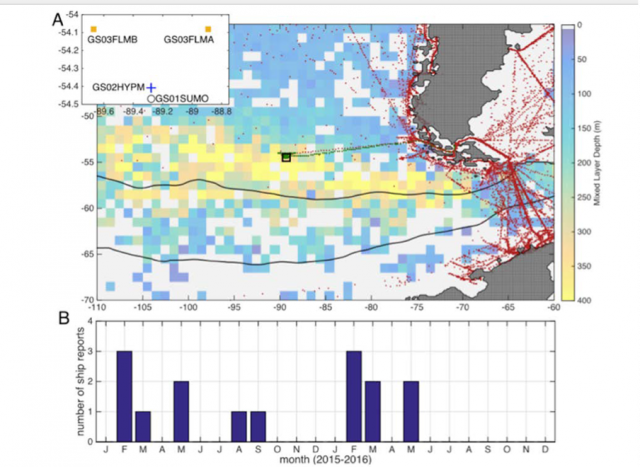Southern Ocean Air-Sea Interaction
Veronica Tamsitt, Climate Change Research Centre, University of New South Wales, Sydney, NSW, Australia and Centre for Southern Hemisphere Oceans Research, CSIRO Oceans and Atmosphere, Hobart, TAS, Australia. Extracted from OOI Science Plan, 2021.
The Southern Ocean plays a critical role in the global ocean uptake of heat and carbon. One key component of understanding the Southern Ocean’s role in climate is the air-sea exchange of heat, carbon dioxide and the input of momentum into the ocean by winds at the sea surface. Historically, we have relied primarily on shipboard observations to measure Southern Ocean air-sea interaction. However, the remoteness, extreme wind and sea states, and seasonal sea-ice cover in the Southern Ocean have resulted in sparse observations and a strong seasonal bias toward the summer (see Figure to right, Ogle et al., 2018; Swart et al., 2019). As a result, there is a large spread in the net air-sea heat flux between different satellite and reanalysis products in the Southern Ocean (e.g. Liu et al. 2011, Swart et al. 2019), and ongoing uncertainty in the magnitude of the Southern Ocean carbon sink (Landschutzer et al., 2015; Gray et al., 2018).
The rapid development of relatively cheap autonomous surface vehicles in recent years has allowed unprecedented access to the Southern Ocean air-sea interface year-round, but these platforms tend to be deployed for limited time periods and have challenges with spatiotemporal aliasing of data (Thomson and Girton, 2017; Swart et al., 2019). Recent deployments of surface flux moorings, specifically the OOI Southern Ocean surface mooring along with the Southern Ocean Flux Site (SOFS) mooring deployed south of Australia (data available here. ), provide the first ever high-quality, detailed, continuous time series of air-sea interaction in the Southern Ocean.
The OOI Southern Ocean surface mooring, deployed for almost five years from 2015 until 2020, was the southernmost, multi-year air-sea flux mooring ever deployed. The mooring design was specially designed to withstand the strong currents and waves of the Southern Ocean, and collected near-continuous meteorological and upper ocean data throughout four separate deployments. The mooring was located in a region where Southeast Pacific Subantarctic Mode Water is formed, which is also a region of high interannual variability in subduction of mode waters that are particularly important for anthropogenic heat and carbon storage in the ocean (Tamsitt et al., 2020; Meijers et al., 2019). The mooring observations provide a unique opportunity to study air-sea interaction from hourly to interannual timescales in the Southern Ocean and to greatly improve weather prediction and reanalysis products in this region (Ogle et al., 2018).
Ogle et al. (2018) used the OOI Southern Ocean mooring data to identify the key role of extreme heat loss events driven by cold Antarctic winds in driving the seasonal mixed layer deepening in the region. The mooring has also captured dramatic year-to-year variations in the wintertime surface ocean heat loss and corresponding mixed layer depth, particularly the winter of 2016, where highly unusual atmospheric conditions following an El Niño event led to unusually weak ocean heat loss and shallow mixed layers (Ogle et al., 2018; Tamsitt et al., 2020). Comparing and contrasting the OOI Southern Ocean mooring with SOFS in the Indian sector of the Southern Ocean has revealed key similarities and differences in the variability of air-sea heat flux in the two regions (Tamsitt et al., 2020).
Although there are no plans to redeploy the Southern Ocean mooring, there is great value in further retrospective analysis of the existing mooring data. These mooring data should be leveraged to further evaluate and improve numerical weather prediction products. The existing five years of OOI Southern Ocean mooring data is hugely valuable, but the time-series is insufficient to evaluate whether reanalysis products accurately represent interannual and decadal variability.
Another important priority for the scientific community is reducing uncertainty in our current quantification of Southern Ocean air-sea CO2 flux and developing the capacity to both predict and monitor how air-sea CO2 flux in this region may change under future climate change. The suite of biogeochemical sensors that were deployed on the OOI Southern Ocean surface mooring provide a unique opportunity to make advances in this quantification of carbon fluxes. In particular, the mooring data provide a valuable opportunity to validate and complement other Southern Ocean in situ carbon system measurements, particularly from biogeochemical Argo floats, as they provide in situ measured wind/atmospheric variables needed to calculate carbon fluxes, high temporal frequency not available on other platforms.
Finally, results and success of the OOI Southern Ocean mooring deployments can help inform future Southern Ocean air-sea interaction observing system design. Such moorings have both the potential to form a Southern Ocean-wide air- sea flux monitoring system (e.g. Wei et al., 2020), and also to act as a core component of process studies to better understand the role of ocean fronts, eddies, and other small-scale features in air- sea interaction.

